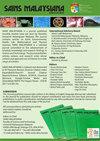基于数量和质量性状的菊花基因型亲缘关系分析
IF 0.8
4区 综合性期刊
Q3 MULTIDISCIPLINARY SCIENCES
引用次数: 0
摘要
通过生物技术方法进行的遗传改良已成功地应用于许多经济上重要的作物,包括观赏植物。伽玛粒子轰击技术已应用于菊花品种Puspita Nusantara,并在不降低其重要市场特性的情况下成功地产生了优质突变体。从数量和质量两个方面评价了47个优势突变基因型的营养和生殖性能,并与3个参考品种(Puspita Nusantara、Stangkon和Arosuko Pelangi)进行了比较。通过评价筛选具有较好性状的优良突变体。结果表明,除节长、花序最宽点宽度、单株花数和小花宽度外,所有菊花基因型在数量性状上均存在差异。叶片无光泽、压痕深度中等、龙骨的存在、小花内外色、花药裂前的花盘色和花药裂后的花盘色6个性状在各基因型中相似。突变无性系G6、G8、C1、KA7、G9、AG0、N9和Q5表现出较好的数量性状。无性系W5与Stangkon具有比较特性,可进一步评价作为替代参考。所选择的突变基因型为农民提供了更好的选择,以种植更具竞争力的品种。本文章由计算机程序翻译,如有差异,请以英文原文为准。
Genetic Relationship Analysis of Chrysanthemum Genotypes Based on Quantitative and Qualitative Characters
Genetic improvements through biotechnological approaches have been successfully employed in many economically important crops, including ornamentals. The gamma-ray particle bombardment has been applied in the chrysanthemum variety Puspita Nusantara and superior mutants has successfully generated without degrading its important marketable characteristics. The vegetative and reproductive performances of 47 superior mutant genotypes from Puspita Nusantara are evaluated and compared with three references varieties, i.e., Puspita Nusantara, Stangkon and Arosuko Pelangi based on the quantitative and qualitative characteristics. The evaluation was carried out to select superior mutants with better characteristics. The results show that all chrysanthemum genotypes exhibited variations in quantitative characteristics, except in node length, the width of the widest point of inflorescence, the number of flowers per plant, and floret width. Six qualitative characters, i.e., non-glossy leaves, medium indentation depth, the existence of keel, inner and outer floret color, disc color before anther dehiscence, and disc color after anther dehiscence were similar in all genotypes. Mutant clones G6, G8, C1, KA7, G9, AG0, N9, and Q5 show preferable quantitative performances than the reference varieties. Clone W5 has comparative characteristics to Stangkon and can be further evaluated for alternative reference. The selected mutant genotypes provide better choices for farmers to plant more competitive varieties.
求助全文
通过发布文献求助,成功后即可免费获取论文全文。
去求助
来源期刊

Sains Malaysiana
MULTIDISCIPLINARY SCIENCES-
CiteScore
1.60
自引率
12.50%
发文量
196
审稿时长
3-6 weeks
期刊介绍:
Sains Malaysiana is a refereed journal committed to the advancement of scholarly knowledge and research findings of the several branches of science and technology. It contains articles on Earth Sciences, Health Sciences, Life Sciences, Mathematical Sciences and Physical Sciences. The journal publishes articles, reviews, and research notes whose content and approach are of interest to a wide range of scholars. Sains Malaysiana is published by the UKM Press an its autonomous Editorial Board are drawn from the Faculty of Science and Technology, Universiti Kebangsaan Malaysia. In addition, distinguished scholars from local and foreign universities are appointed to serve as advisory board members and referees.
 求助内容:
求助内容: 应助结果提醒方式:
应助结果提醒方式:


